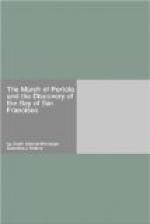[22] Rancheria is the name given to an Indian village or town.
[23] The Valley of the Bears.
[24] The diarists applied the word canada to either a canon or an open valley.
[25] The word ensenada, much used by the Spanish explorers, means a bight or open roadstead, not an enclosed and protected bay.
[26] “Transportar en Xamus al Modo que cominan las mujeres en Andalucia,” Crespi: Palou’s Noticias de la Nueva California, ii. 181.
[27] The names given on this portion of the route have all disappeared, but are here given as a suggestion to the Ocean Shore Railroad.
[28] The Fleas.
[29] It must be borne in mind that what they called the Bay or Port of San Francisco was that stretch of water reaching from Point Reyes to Point San Pedro and later known as the Gulf of the Farallones.
[30] Professor George Davidson says that what was seen by Portola from the Montara mountains was the break in the Ballenos cliffs, a deep narrow valley which runs straight from Ballenos bay to Tomales bay, fourteen miles.
[31] The Golden Gate and Bay of San Francisco.
[32] The Bay of San Francisco continued to be called the “Estero,” until some time after Colonel Anza established the presidio and mission of San Francisco in 1776.
[33] The present name, Canada de San Andres, was given by Rivera, Nov. 30, 1714.
[34] On November, 1774, Rivera came up the peninsula on an exploring expedition and on the spot where he had camped with the first expedition in 1769, he planted a cross to mark the place for a mission. In March, 1776, Col. Juan Bautista de Anza, coming to select sites for the Presidio and Mission of San Francisco, notes this cross on the bank of the Arroyo de San Francisco (now San Francisquito creek), about one hundred paces above the great redwood tree, and says the plan for a mission there was abandoned because the creek was dry in summer. I note this explanation because an excellent authority has located Portola’s camp on Redwood creek.
[35] I give to Ortega the credit of discovering the Golden Gate and the Straits of Carquinez. The testimony seems sufficient to me.
[36] Vizcaino to the King, May 23, 1603. Pub. Hist. Socy. of Southern California, Vol. ii, Part 1.
[37] On the day of the Holy Innocents it was not possible to say mass. We are sorry for it, because it is the only feast day in all the journey up to the present that we have been without mass. We are stuck in a mud hole and are unable to move from the place where we are all wet through, and it is not possible to make a journada to a plain that is dry for this is bubbling up water — Crespi, Diario.
[38] Crespi: Diario.
[39] Palou: Noticias de la Nueva California.
Data Regarding Don Gaspar de Portola After He Left California
by E. J. Molera




